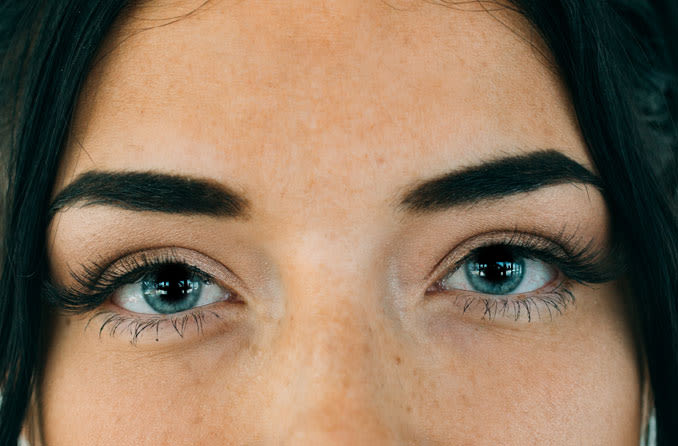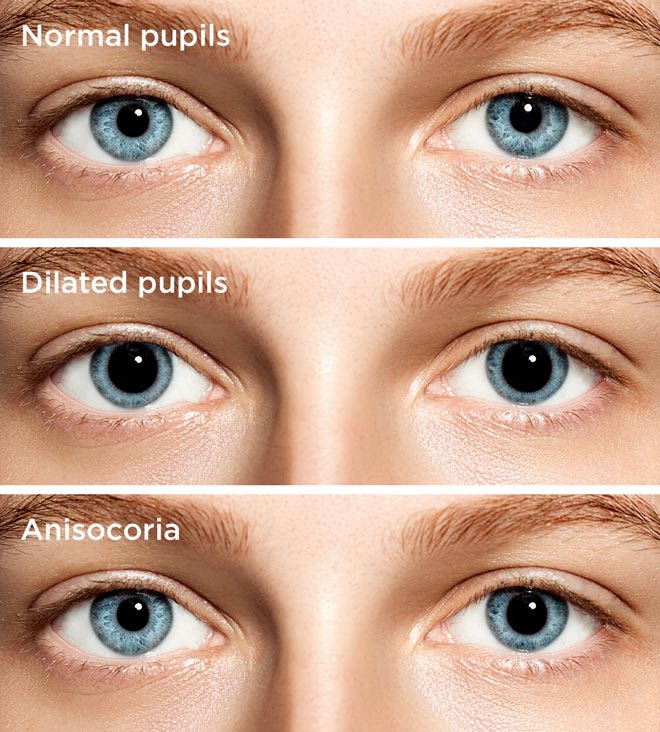What causes dilated pupils (dilated eyes)?

Dilated pupils are pupils that are larger than normal. They are sometimes called dilated eyes.
The size of your pupils is controlled by tiny muscles in the colored part of your eye (iris) and the amount of light reaching your eyes.
In bright light, your pupils constrict (get smaller) to prevent too much light from entering your eyes. In dim lighting, your pupils dilate (get larger) to allow more light in.
Normal pupil size generally ranges from 2.0 to 4.0 millimeters (mm) in bright light, and 4.0 to 8.0 mm in the dark. To some degree, pupil size tends to get smaller with age.
In one study of 500 Americans ages 18 to 34 years, average pupil sizes in three different lighting conditions were found to be:

3.35 mm in direct light
3.86 mm in normal room lighting
6.41 mm in near-total darkness
If your pupils are significantly larger than these averages, you have dilated pupils.
A dilated pupil can sometimes still react to light — that is, get smaller in bright light or when a light is shined at the eye. But typically, dilated eyes don’t respond normally to light.
A large pupil that is completely unresponsive to light is called a "fixed" dilated pupil.
Dilated pupils aren't the same as anisocoria, a common condition where both pupils react normally to light but differ in size by about a half-millimeter or more. Anisocoria is benign and affects about 20% of the population.
SEE RELATED: Small pupils: What do they mean?
| Do your pupils seem larger than normal? |
|---|
| If you've noticed your eyes are unusually dilated (larger) or one eye is dilated more than the other, call an eye doctor! It's normal for your pupils to dilate more the darker your surroundings. However, if your eyes are fully dilated even in a bright environment or if your eyes don't seem to be dilating as they should, it's time to get your eyes checked. Your pupils should also dilate symmetrically. If one pupil is noticeably larger than the other, you may have something called anisocoria. An eye doctor can help. |
What causes dilated pupils?
The most common dilated pupil causes include:
Medications
The following prescription and non-prescription medicines can cause your pupils to dilate and affect their ability to react to light:
Antihistamines
Decongestants
Tricyclic antidepressants
Motion sickness medicines
Anti-nausea medicines
Anti-seizure drugs
Medications for Parkinson's disease
Botox and other medications containing botulinum toxin
Atropine (used for myopia control and other medical purposes)
READ NEXT: Floppy Iris Syndrome
Eye injury
A serious, penetrating eye injury can damage your iris and cause the pupil to become dilated and irregular in shape. Sometimes, this sort of injury can occur during an eye surgery, such as a complicated cataract surgery or a corneal transplant.
Brain injury or disease
A head injury, stroke or brain tumor can affect how your pupils react to light and cause dilated pupils. One or both eyes may be affected.
This is why you see physicians checking an athlete's pupils with a penlight following head trauma sustained during sporting events, or when a patient arrives at a hospital emergency department with other possible stroke symptoms.
Recreational drug use
Research has shown that alcohol and marijuana — separately or in combination — can reduce your eyes' ability to recover from exposure to a bright light source (such as oncoming headlights at night) and adapt to changing light conditions. This effect can last two hours or longer after drug ingestion.
However, the substances themselves do not cause your pupils to dilate.
A number of illegal drugs, however, do directly cause dilated pupils. This slows your eyes' ability to react to light.
These drugs include:
Amphetamines
LSD
MDMA (Ecstasy)
SEE RELATED: Eye dilation FAQs
Benign episodic unilateral mydriasis
This is an unusual but harmless condition where a person experiences sporadic episodes of one pupil suddenly becoming dilated, often accompanied by blurry vision, headache and eye pain.
Young women who are prone to migraine appear to have the highest risk of benign episodic unilateral mydriasis. In one study, the median duration of the episodes was 12 hours (some lasted much longer) and the median frequency was two to three episodes per month.
The condition resolves and the pupil returns to normal size and function without treatment.
Adie's pupil
Also called Adie's tonic pupil or tonic pupil, this is a rare neurological disorder where one pupil is larger than normal and is slow to react to light. Sometimes, the pupil does not constrict at all.
This pupil abnormality may be accompanied by poor or absent tendon reflexes. When this occurs, the condition is called Adie's syndrome.
Generally, the cause of Adie's tonic pupil is unknown; but in some cases, it may be associated with trauma, surgery, poor blood circulation or infection. There's no cure for Adie's pupil or Adie's syndrome.
Congenital aniridia
This is a rare condition where a person is born with a partially or completely absent iris, resulting in a very large "pupil." Aniridia usually affects both eyes and is accompanied by other serious eye problems such as congenital cataracts, glaucoma, incomplete development of the retina and optic nerve, nystagmus, and decreased visual acuity.
Because there is little or no iris to regulate the amount of light entering the eye, people with aniridia are very sensitive to light.
READ NEXT: What is a blown pupil?
Sexual attraction
It's true — researchers have found that pupil dilation appears to correspond to adult men and women's sexual interest in other adults. But there's a catch.
One recent study showed that the pupils of male subjects dilated when they viewed images of women they found sexually attractive, whereas the pupils of female subjects typically dilated in response to images of attractive men and women alike. The study authors concluded the reason for this is unclear and that further research is warranted.
Treatment for dilated pupils
If you or someone else notices you have dilated pupils or one of your pupils looks larger than the other after head trauma, seek medical attention immediately.
The same is true if you experience sudden dizziness, headache, confusion, balance problems or other symptoms of a possible stroke.
If you notice dilated pupils after you've started taking one of the medications noted above, call your prescribing doctor for advice.
In cases other than those described above, call your eye doctor immediately for advice if you notice your pupils are dilated — especially if it comes on suddenly.
If you have dilated pupils or your pupils react slower than normal to changing light conditions, you will be more sensitive to sunlight. Eyeglasses that darken automatically in daylight or sunglasses with polarized lenses can make your eyes feel more comfortable outdoors.
Custom prosthetic contact lenses can also help reduce light sensitivity caused by dilated eyes. These lenses give the appearance of having equal pupils of normal size. Prosthetic contacts are especially beneficial for cases of aniridia and large, irregular pupils caused by trauma.
SEE RELATED: What is a Dilated Eye Exam?
Clinical Methods: The History, Physical, and Laboratory Examinations. 3rd edition. Chapter 58: The Pupils. Butterworths. Boston. 1990.
Benign episodic unilateral mydriasis. Clinical characteristics. Ophthalmology. November 1995.
The prevalence of simple anisocoria. American Journal of Ophthalmology. July 1987.
Adie syndrome. National Organization for Rare Diseases. Accessed May 2021.
An evaluation of pupil size standards used by police officers for detecting drug impairment. Optometry. March 2004.
Marijuana, alcohol, and combined drug effects on the time course of glare recovery. Psychopharmacology. January 1978.
Pupillary response as an age-specific measure of sexual interest. Archives of Sexual Behavior. February 2016.
Sexual arousal: the correspondence of eyes and genitals. Biological Psychology. January 2015.
Page published on Friday, February 1, 2019






